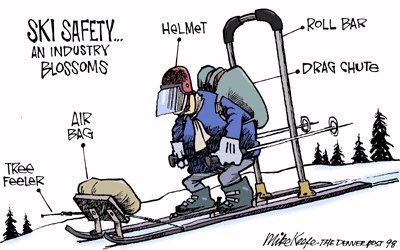This is the first of a series of 3 articles. Here we look at how our muscles need to perform to help keep us injury free on the slopes. In Parts II and III we’ll get to the exercises: what to do and how.
Skiing is a dangerous, silly activity. Why would anyone want to throw themselves down a steep slope covered in snow with a couple of long thin appendages strapped to their feet?! You’re just asking for trouble aren’t you?
[Image from: quotesgram.com]
Well, there in is the addiction. The exhilaration of flying down the slope at speed, staying upright, gaining mastery over the skis, the snow, being in control. Who wouldn’t want to experience THAT?
Which brings me to the point of this article. Before you reach the 10th Dan of skiing and achieve sensei status, there are hundreds of opportunities to go wrong and, going wrong in skiing can be devastating. A minor error can mean a massive loss of balance, a twist of your skis and a severe knee injury.
Preparation
Unfortunately, many people here in the UK are ill prepared when they embark on their skiing holiday, their body isn’t quite resilient enough to cope with the stresses and strains of the sport and injury risk is high. This isn’t entirely their fault. How many opportunities are there here to just ‘nip out’ for a quick ski? Secondly, most people don’t know that the type of conditioning you need to do to protect against injury is quite different to the conditioning that you need to do to get ‘fit’ for the sport.
Wall Squats Anyone?
Who does wall squats? A sadistic exercise where you see how long you can remain in a squatted position with your back against a wall. It burns, REALLY burns! So, it must be doing something, right? Indeed, this exercise is great for muscular endurance, helping you keep in that similar position as you nail it down the slopes. BUT, this is no good at all for injury prevention.
Suffered an Injury?
Have your ever been injured? How quickly did it happen? Chances are that it happened really quickly. Most major injuries to the knee for example happen in less time than it takes to blink an eye! So you see, we need our muscles to respond rapidly with a lot of force to protect and stabilise our joints. This require a particular type of training to condition the ‘fast’ muscle fibres and motor units that offer us this protection. When we stop training for whatever reason and unfortunately as we get older, this is the first thing to decondition – we lose our fast responses and become more suited to endurance.
What to Do?
So what can we do about it? Well in Part II I’ll tell you how to focus your resistance conditioning to tap into the fast muscle capacity and to build-up your rapid force generation. In Part III we’ll get a little more dynamic and apply this to rapid movements, weight transference and balance.
Planning a Holiday?
If you’re planning a skiing holiday, sign yourself up to a gym! Make sure you click here for more information on skiing and injures.
For a tailored programme of injury prevention and conditioning for skiing see here, or get in touch with Dr Claire Minshull, Rehabilitation & Conditioning Specialist. Claire specialises in providing support and conditioning for those who’ve recently been injured, had surgery or who are suffering from degenerative changes.



